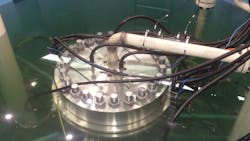High-power subsea pump attains TRL 4 qualification
Saipem and Curtiss-Wright have completed qualification to Technology Readiness Level 4 (TRL 4) of an all-electric seabed barrier fluid-less pump.
The technology, based on proprietary solutions devised for the nuclear sector, should enable subsea injection of treated seawater into a reservoir, Saipem said, extending the lifecycle of subsea fields.
Conventional pumping systems feature a barrier fluid as a coolant, lubricant and insulation medium. In the Saipem/Curtiss-Wright design, seawater is used to cool and lubricate the subsea pump, while the motor is protected by a canned casing said to be appropriate for deepwater applications.
The absence of the barrier fluid is said to avoid the need for its constant replenishment, with the risk of seawater contamination. Saipem’s all-electric approach replaces the conventional hydraulic umbilicals with power/control cables, which the company claims lead to lower costs.
The system, it adds, represents is the first seal-less, barrier fluid-less subsea pump with such high power.
Since signing an exclusive collaboration agreement to develop the technology in 2018, the partners have manufactured a 3-MW full-scale prototype, which has been tested extensively in water, confirming the anticipate performance, robustness and reliability.
This new solution is also certified to accommodate proprietary Saipem subsea treatment technologies such as the subsea desulfation technique SPRINGS, co-owned with TotalEnergies and Veolia.
Both TotalEnergies and Petrobras witnessed and endorsed the TRL 4 milestone.
